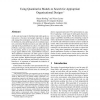Free Online Productivity Tools
i2Speak
i2Symbol
i2OCR
iTex2Img
iWeb2Print
iWeb2Shot
i2Type
iPdf2Split
iPdf2Merge
i2Bopomofo
i2Arabic
i2Style
i2Image
i2PDF
iLatex2Rtf
Sci2ools
AAMAS
2008
Springer
2008
Springer
Using quantitative models to search for appropriate organizational designs
As the scale and scope of distributed and multi-agent systems grow, it becomes increasingly important to design and manage the participants' interactions. The potential for bottlenecks, intractably large sets of coordination partners, and shared bounded resources can make individual and high-level goals difficult to achieve. To address these problems, many large systems employ an additional layer of structuring, known as an organizational design, that assigns agents different roles, responsibilities and peers. These additional constraints can allow agents to operate more efficiently within the system by limiting the options they must consider. Different designs applied to the same problem will have different performance characteristics, therefore it is important to understand the behavior of competing candidate designs. In this article, we describe a new representation for capturing such designs, and in particular we show how quantitative information can form the basis of a flexi...
AAMAS 2008 | Air Force Research Laboratory | Defense Advanced Research Projects Agency | Designs | Intelligent Agents |
| Added | 08 Dec 2010 |
| Updated | 08 Dec 2010 |
| Type | Journal |
| Year | 2008 |
| Where | AAMAS |
| Authors | Bryan Horling, Victor R. Lesser |
Comments (0)

